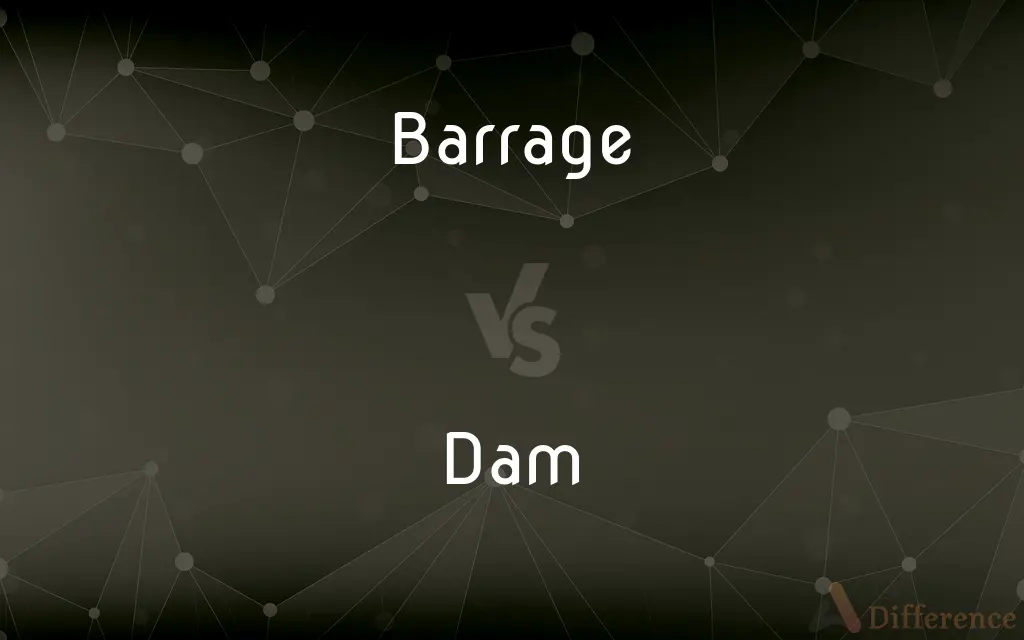Barrage vs. Dam — What's the Difference?
Edited by Tayyaba Rehman — By Urooj Arif — Updated on April 6, 2024
A barrage controls river flow without storing water, while a dam stores water to create a reservoir for various uses.

Difference Between Barrage and Dam
Table of Contents
ADVERTISEMENT
Key Differences
Barrage refers to a structure that is built across a river to control water flow and regulate water levels, primarily for navigation and irrigation purposes. It consists of gates that can be opened or closed to control the amount of water passing through. This structure does not typically store water in a large reservoir behind it but allows water to be diverted for use. Dam, on the other hand, is a barrier constructed across a river or stream to hold back water and create a reservoir. Dams are used for water supply, irrigation, flood defenses, and hydroelectric power generation. They significantly alter the environment upstream and downstream, creating large lakes that can be used for various purposes.
While barrages are primarily focused on controlling water flow and managing irrigation without significantly altering the landscape, dams serve multiple functions, including water storage, flood control, and electricity generation. The construction of a dam involves creating a significant barrier that can withstand the pressure of the stored water, whereas a barrage might be less substantial in construction, designed instead to regulate water flow.
Barrages often support navigation along a river by maintaining sufficient water depth, allowing ships and boats to traverse areas that might otherwise be too shallow. Dams, by creating reservoirs, can also facilitate recreation and tourism, such as boating, fishing, and waterfront activities, although this is not their primary purpose. The environmental impact of a dam is typically more significant than that of a barrage, affecting water quality, flow, and ecosystem dynamics both upstream and downstream.
The technology and engineering behind dams and barrages also differ. Dams require robust construction techniques to handle the massive volume of water they store, including spillways to manage overflow and prevent damage. Barrages, with their adjustable gates, require mechanisms for raising and lowering these gates to manage water levels and flow rates, focusing more on precision control than on water retention.
While both barrages and dams are critical infrastructures for managing water resources, their functions, construction, and impacts on the environment and local communities differ significantly. Dams are versatile structures for water storage and power generation, altering landscapes to create reservoirs, while barrages are specialized for water flow control, supporting irrigation and navigation without creating large reservoirs.
ADVERTISEMENT
Comparison Chart
Primary Purpose
Control water flow and regulate levels for irrigation and navigation
Store water to create a reservoir for water supply, power, irrigation
Water Storage
Does not create a large reservoir
Creates a reservoir to store a large volume of water
Construction Focus
Gates to control water flow
Robust barrier to withstand water pressure, with spillways
Environmental Impact
Minimal landscape alteration, focuses on flow regulation
Significant alteration, creating lakes and affecting ecosystems
Uses
Irrigation, navigation
Water supply, hydroelectric power, flood control, recreation
Compare with Definitions
Barrage
Supports river navigation.
The barrage maintains water depth for safe boat passage.
Dam
Used for hydroelectric power generation.
The hydroelectric dam provides electricity to millions.
Barrage
Facilitates irrigation by diverting water.
Farmers downstream benefit from the barrage during dry seasons.
Dam
Creates recreational and tourism opportunities.
The lake formed by the dam is a popular spot for boating and fishing.
Barrage
Minimally alters the landscape.
Unlike a dam, the barrage did not create a large reservoir.
Dam
Stores water in a reservoir for various uses.
The dam's reservoir supplies water to the entire region.
Barrage
A structure to control water flow and level.
The new barrage improved navigation on the river.
Dam
Affects upstream and downstream ecosystems.
The construction of the dam altered the natural river flow and habitat.
Barrage
Designed with adjustable gates.
The barrage's gates were raised to prevent flooding.
Dam
Involves substantial construction to hold back water.
The dam was engineered to withstand extreme flood events.
Barrage
A coordinated discharge or bombardment using artillery, missiles, or firearms, especially when directed against an enemy's lines, as to provide cover for advancing troops.
Dam
A dam is a barrier that stops or restricts the flow of surface water or underground streams. Reservoirs created by dams not only suppress floods but also provide water for activities such as irrigation, human consumption, industrial use, aquaculture, and navigability.
Barrage
An artificial obstruction, such as a dam or irrigation channel, built in a watercourse to increase its depth or to divert its flow.
Dam
A barrier constructed to hold back water and raise its level, forming a reservoir used to generate electricity or as a water supply
The dam burst after torrential rain
The Hoover Dam
Barrage
An overwhelming, concentrated outpouring, as of words or requests
A barrage of criticism.
Dam
A rubber sheet used to keep saliva from the teeth during dental operations, or as a prophylactic device during cunnilingus and anilingus.
Barrage
To direct a barrage at.
Dam
The female parent of an animal, especially a domestic mammal.
Barrage
An artificial obstruction, such as a dam, in a river designed to increase its depth or to divert its flow.
Dam
Build a dam across (a river or lake)
The river was dammed to form Lake Powell
Barrage
(military) A heavy curtain of artillery fire directed in front of one's own troops to screen and protect them.
Dam
A barrier constructed across a waterway to control the flow or raise the level of water.
Barrage
A concentrated discharge of projectile weapons.
Dam
A body of water controlled by such a barrier.
Barrage
(by extension) An overwhelming outburst of words, especially of criticism.
Dam
A barrier against the passage of liquid or loose material, as a rubber sheet used in dentistry to isolate one or more teeth from the rest of the mouth.
Barrage
(fencing) A "next hit wins" contest to determine the winner of a bout in case of a tie.
Dam
A female parent of an animal, especially a domesticated mammal such as a horse.
Barrage
Type of firework containing a mixture of firework types in one single-ignition package.
Dam
(Archaic) A mother.
Barrage
(transitive) To direct a barrage at.
Dam
To hold back or confine by means of a dam.
Barrage
An artificial bar or obstruction placed in a river or watercourse to increase the depth of water; as, the barrages of the Nile.
Dam
To close up; obstruct
He tried to dam his grief.
Barrage
The rapid and continuous delivery of linguistic communication (spoken or written)
Dam
A structure placed across a flowing body of water to stop the flow or part of the flow, generally for purposes such as retaining or diverting some of the water or retarding the release of accumulated water to avoid abrupt flooding.
A dam is often an essential source of water to farmers of hilly country.
Barrage
The heavy fire of artillery to saturate an area rather than hit a specific target;
They laid down a barrage in front of the advancing troops
The shelling went on for hours without pausing
Dam
The water reservoir resulting from placing such a structure.
Boats may only be used at places set aside for boating on the dam.
Barrage
Attack with a barrage;
The speaker was barraged by an angry audience
Dam
(dentistry) A device to prevent a tooth from getting wet during dental work, consisting of a rubber sheet held with a band.
Dam
A reservoir.
Dam
A firebrick wall, or a stone, which forms the front of the hearth of a blast furnace.
Dam
Female parent, mother, generally regarding breeding of animals.
Dam
A kind of crowned piece in the game of draughts.
Dam
(India) An obsolete Indian copper coin, equal to a fortieth of a rupee.
Dam
A former coin of Nepal, 128 of which were worth one mohar.
Dam
(transitive) To block the flow of water.
Dam
Damn.
Dam
Damn.
Dam
A female parent; - used of beasts, especially of quadrupeds; sometimes applied in contempt to a human mother.
Our sire and dam, now confined to horses, are a relic of this age (13th century) . . . .Dame is used of a hen; we now make a great difference between dame and dam.
The dam runs lowing up and down,Looking the way her harmless young one went.
Dam
A king or crowned piece in the game of draughts.
Dam
A barrier to prevent the flow of a liquid; esp., a bank of earth, or wall of any kind, as of masonry or wood, built across a water course, to confine and keep back flowing water.
Dam
A firebrick wall, or a stone, which forms the front of the hearth of a blast furnace.
Dam
To obstruct or restrain the flow of, by a dam; to confine by constructing a dam, as a stream of water; - generally used with in or up.
I'll have the current in this place dammed up.
A weight of earth that dams in the water.
Dam
To shut up; to stop up; to close; to restrain.
The strait pass was dammedWith dead men hurt behind, and cowards.
Dam
A barrier constructed to contain the flow of water or to keep out the sea
Dam
A metric unit of length equal to ten meters
Dam
Female parent of an animal especially domestic livestock
Dam
Obstruct with, or as if with, a dam;
Dam the gorges of the Yangtse River
Common Curiosities
Can a barrage help in flood control?
Barrages can help manage flood risks by controlling the release of water, although dams are more effective for large-scale flood control.
Do barrages affect fish and aquatic life?
Yes, like dams, barrages can affect aquatic ecosystems by altering water flow and access to breeding grounds.
What is the main difference between a barrage and a dam?
The main difference is that a barrage controls water flow without storing significant amounts of water, while a dam stores water in a reservoir.
Can both barrages and dams generate electricity?
While dams are commonly used for hydroelectric power, barrages can also be equipped to generate power but are less common.
Can the construction of a dam lead to displacement?
Yes, dam construction can lead to the displacement of communities and wildlife due to reservoir creation.
Are there environmental benefits to building a barrage?
Barrages can improve water availability for agriculture and help maintain river ecosystems by regulating flow.
Is it more expensive to build a dam or a barrage?
Generally, dams are more expensive due to their large scale and the complexity of managing water storage.
How do dams contribute to renewable energy?
Dams generate hydroelectric power, a renewable energy source, by using water flow to turn turbines.
Why are dams considered to have a significant environmental impact?
Dams create reservoirs that flood large areas, affecting ecosystems, wildlife habitats, and local communities.
How do barrages support irrigation?
Barrages divert water through channels or gates to irrigate agricultural land, especially during dry periods.
Share Your Discovery

Previous Comparison
Brazer vs. Grazer
Next Comparison
Portrait vs. ProfileAuthor Spotlight
Written by
Urooj ArifUrooj is a skilled content writer at Ask Difference, known for her exceptional ability to simplify complex topics into engaging and informative content. With a passion for research and a flair for clear, concise writing, she consistently delivers articles that resonate with our diverse audience.
Edited by
Tayyaba RehmanTayyaba Rehman is a distinguished writer, currently serving as a primary contributor to askdifference.com. As a researcher in semantics and etymology, Tayyaba's passion for the complexity of languages and their distinctions has found a perfect home on the platform. Tayyaba delves into the intricacies of language, distinguishing between commonly confused words and phrases, thereby providing clarity for readers worldwide.














































